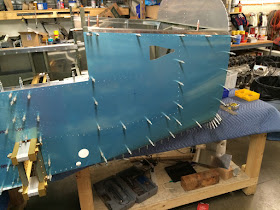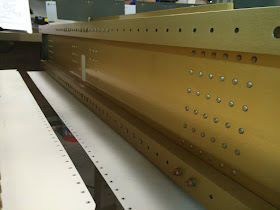Back from AirVenture 2015 with some new swag!
Among a few other events, we attended Van's official RV builder's dinner banquet on Tuesday night, which was attended by around 400 people and included a raffle drawing of maybe a dozen or so prizes ranging from t-shirts to tools to gift certificates. Neither Sarah nor I are typically too prone to win prizes at these kinds of events, but as luck would have it we both won something. Sarah won a Van's t-shirt and I won a Cleaveland 3/32" dimple die set... Yay! Both are pictured above. Our sincerest thanks go out to Van and crew, and Cleaveland Tool as well for the gifts... they will be put to good use, we promise!
Anyway, with all the excitement from Oshkosh winding down, bags unpacked, and things settling back into the normal groove it was time to pick up building where we left off. We had a relatively short night in the shop tonight but seemed to get a good amount done. We finished riveting all four fuselage side channels to the firewall and forward bulkheads, and attached the forward fuse longerons to the firewall gusset as well.
Mike riveting the F-1013-L longeron to the F-1001J-L gusset... happy to be back to building!
Sarah also stepped up to the plate with a bold move as well tonight... as anyone who reads this blog knows, I am so fortunate to have "SOS" with this build (significant other support). She is out here in the shop with me quite often and does an excellent job with anything from drilling to deburring to riveting to prosealing. However, she's always been reluctant to read directly from the plans and actually do a part of the build herself without my direct involvement/supervision/etc for fear of messing something up. All charged up from a week at Oshkosh, however, that changed tonight. While I was on a one-man-task pounding some rivets she asked, "What can I do?" and in short order she was reading from page 29-19 and fetching some parts from the shelf to start fabricating the rear vent brackets all on her own. Most of that can be done in parallel as a separate task while I finish some of the one-person tasks with the side skins... Awesome!
Aside from that, the next step is to begin attaching the skins themselves, but before we can do that we'll need to finish countersinking a few of those hard-to-reach holes around the spars. It's only maybe 6 or 7 holes (out of several hundred) left to do, but they will take some time and it sounded like a good stopping point for tonight.
"Fifi" the B-29 is in town at KCID this week and over the weekend, and although we already just spent some quality time with her at Oshkosh, we may be spending a bit more time with her through our local EAA chapter helping the CAF with logistics and security-type tasks over the weekend. If we're not out there doing that, we'll be in the garage working on the RV!






















































